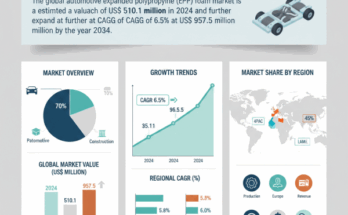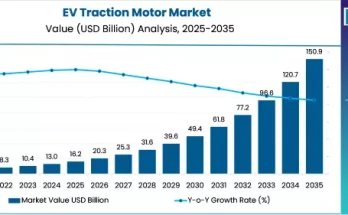As vehicle ownership rises globally and consumers demand higher-quality interiors, the automotive mats market is undergoing significant transformation. From basic rubber mats to premium, tech-enhanced, and eco-friendly alternatives, automotive mats have become essential for vehicle protection, comfort, and aesthetic appeal. The market is expanding across both original equipment manufacturer (OEM) and aftermarket segments, with trends influenced by consumer preferences, sustainability concerns, and innovations in material science.
Market Overview
Automotive mats serve as both functional and stylistic components of vehicles. They protect floors from dirt, spills, and wear, while enhancing the overall interior design. Modern mats go beyond traditional rubber and carpet, incorporating advanced thermoplastic elastomers, EVA foam, and engineered polymers. Some even feature antimicrobial properties, heating elements, or embedded sensors, particularly in electric and luxury vehicles.
The market can be segmented by:
- Material: Rubber, carpet, thermoplastic elastomers, EVA, and hybrid composites.
- Mat Type: All-weather, carpeted, custom-fit, and universal mats.
- Design: Standard, premium, laser-cut, or logo-embossed.
- Vehicle Type: Passenger cars, SUVs, trucks, and commercial vehicles.
Drivers of the Automotive Mats Market
Rising Vehicle Ownership
Global growth in vehicle production and ownership, particularly in emerging markets, is driving demand for automotive mats. As more consumers purchase vehicles, both OEM and aftermarket segments see consistent demand for protective and aesthetic interior accessories.
Customization and Premiumization
Consumers increasingly seek personalized interiors. Custom-fit mats, branded carpet mats, and high-end rubber designs appeal to drivers who value both function and style. Premium mats with odor-resistant, antimicrobial, and eco-friendly properties are growing in popularity.
Technological Advancements
Material innovations have transformed the market. Thermoplastic elastomers and engineered foams offer superior durability, water resistance, and ease of cleaning. Some mats now integrate heating systems or sensors, catering to luxury and electric vehicles.
Sustainability Awareness
Environmental concerns are influencing consumer choices and manufacturing practices. Eco-friendly mats made from recycled or biodegradable materials align with global sustainability trends, while meeting regulatory standards in Europe and North America.
Regional Insights
North America
The U.S. and Canada are mature markets with high vehicle penetration. Seasonal climates and diverse terrains fuel demand for all-weather, rugged mats. The aftermarket segment is strong, with consumers investing in custom-fit, luxury, and hygiene-focused mats. Innovations like laser-cut carpets, odor-resistant coatings, and eco-friendly materials are gaining traction.
Europe
Europe emphasizes OEM integration and eco-conscious designs. Consumers favor sustainable, high-quality mats made from recycled or biodegradable polymers. Compact car prevalence drives demand for slim, lightweight mats, while premium vehicles boost interest in custom and luxury options.
Asia-Pacific
Asia-Pacific is the fastest-growing region, driven by rising vehicle ownership in China, India, and Southeast Asia. Mats are essential for protection against dust, mud, and monsoon conditions, supporting demand for durable rubber and PVC mats. Increasing middle-class incomes are encouraging adoption of premium and customized mats. E-commerce platforms are expanding access to diverse mat designs, further driving growth.
Middle East & Africa
Harsh climates and rugged terrains necessitate durable, easy-to-clean mats with UV resistance. Thermoplastic and rubber mats dominate, especially in SUVs and utility vehicles. Rising vehicle ownership and automotive retail investments in Africa present opportunities for both OEM and aftermarket mat suppliers.
Challenges and Restraining Factors
Price Competition
The aftermarket segment is highly fragmented, with numerous local suppliers offering low-cost products. This creates pricing pressure for premium brands, making differentiation challenging.
Regulatory Compliance
Environmental regulations in mature markets require sustainable production methods, limiting use of certain plastics and chemicals. Meeting these standards can increase costs and complexity for manufacturers.
Limited Awareness in Emerging Markets
In developing regions, consumers often prioritize affordability over advanced features. Basic mats dominate, and adoption of premium, odor-resistant, or eco-friendly options remains limited.
Country-Specific Outlook
United States
The U.S. market benefits from high aftermarket demand and vehicle diversity, including SUVs and trucks. Consumers are increasingly seeking mats that combine functionality, aesthetics, and hygiene. Premium mats with custom cuts, logo embossing, and antimicrobial coatings are popular among luxury vehicle owners.
China
China’s market growth is fueled by its position as the world’s largest automotive producer. Rising vehicle ownership, urbanization, and consumer preferences for customized interiors drive both OEM and aftermarket demand. E-commerce platforms further facilitate access to premium and functional mats.
India and Southeast Asia
Emerging middle-class populations are driving growth in automotive mats. Basic mats remain prevalent, but demand for premium, custom-fit, and eco-friendly mats is increasing alongside rising disposable incomes and premium vehicle adoption.
Europe
Countries like Germany, France, and the U.K. lead in sustainable and high-quality mats. Consumer demand favors durable, eco-friendly options, aligning with regional environmental regulations and circular economy initiatives.
Strategic Opportunities
Invest in Product Innovation
Manufacturers can focus on developing mats with advanced features, such as heating, sensors, antimicrobial properties, and eco-friendly materials.
Expand Geographic Presence
Emerging markets in Asia-Pacific, Middle East, and Africa offer significant growth potential for both OEM and aftermarket segments.
Enhance Customization Options
Custom-fit mats, premium designs, and branded products appeal to consumers seeking personalization, supporting premiumization strategies.
Leverage E-Commerce
Online sales platforms provide opportunities to reach a broader audience, especially for aftermarket and niche products.
Sustainability Initiatives
Adopting recyclable and biodegradable materials, reducing production waste, and meeting regulatory standards can attract environmentally conscious consumers.
Future Outlook
The automotive mats market is set to experience steady growth as vehicle ownership rises and consumers demand functional, stylish, and sustainable interior accessories. Advances in materials, technological integration, and customization options will continue to shape market dynamics. Manufacturers that focus on innovation, premiumization, and sustainability are well-positioned to capitalize on emerging opportunities globally.
Conclusion
Automotive mats are evolving from simple protective accessories to multifunctional, premium, and sustainable components of vehicle interiors. Growth in vehicle production, rising consumer expectations, and advancements in material science and technology are driving innovation and market expansion. Stakeholders who invest in high-quality, customizable, and eco-friendly products are poised to lead the automotive mats market in the coming decade.



